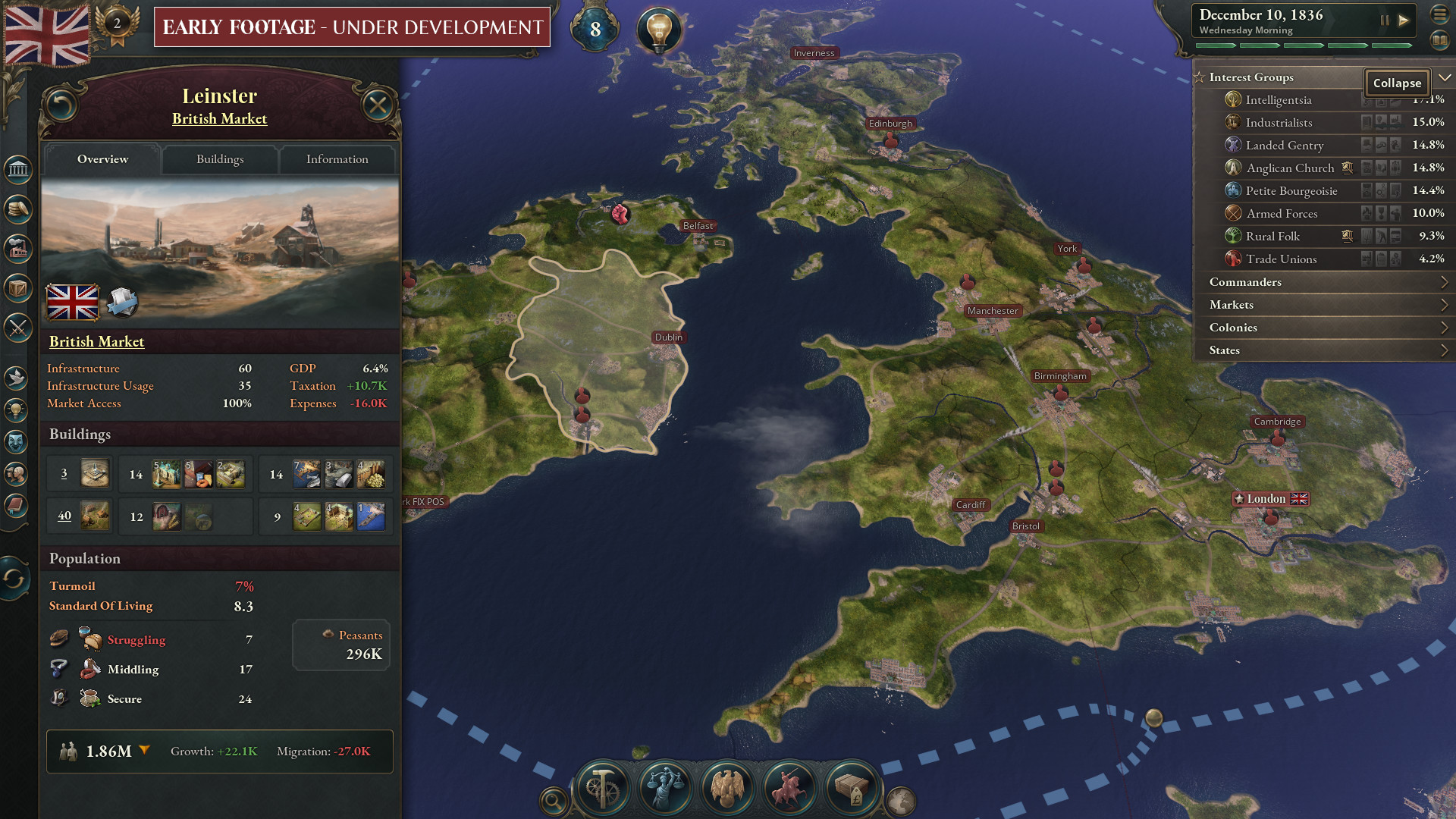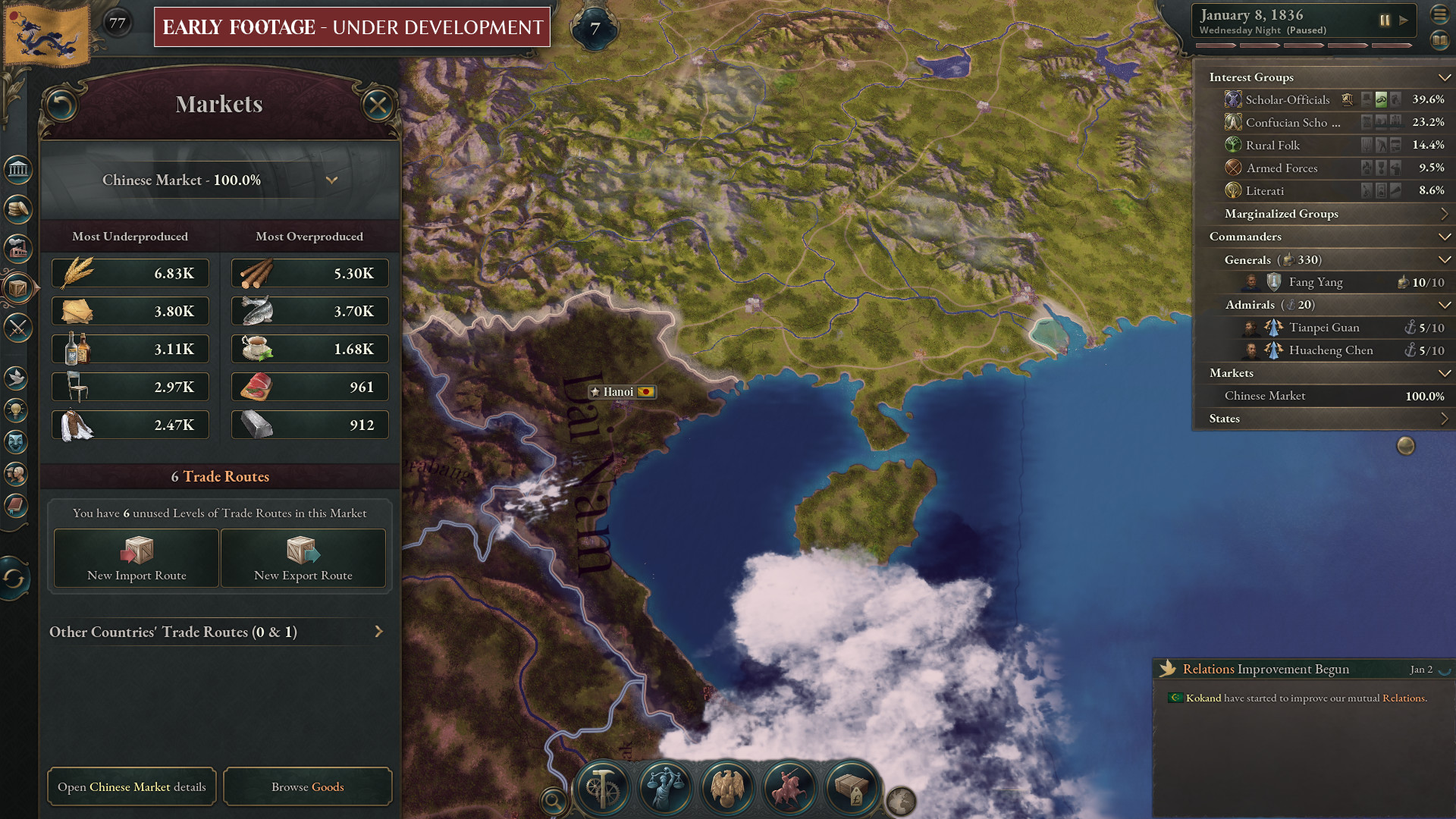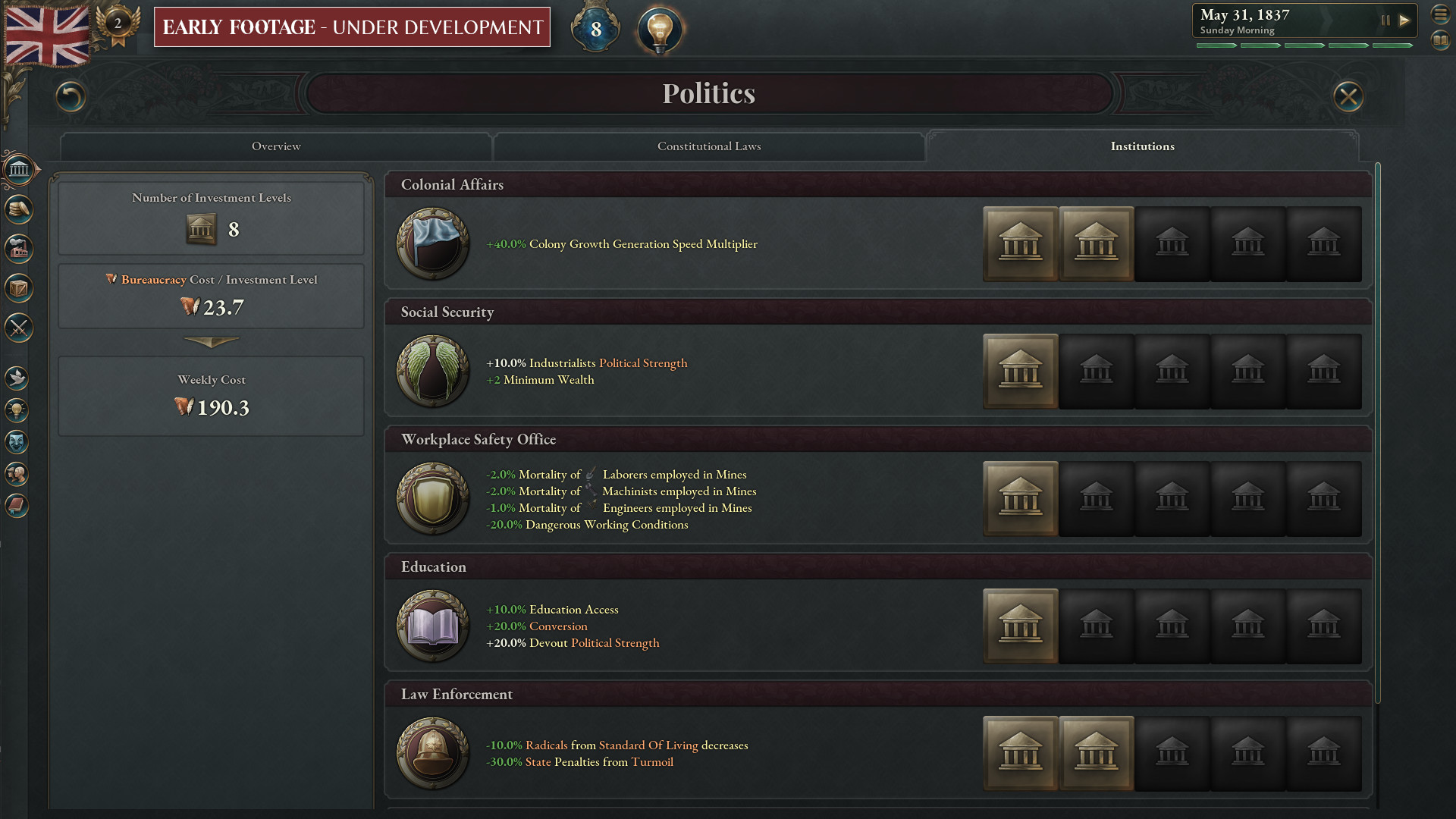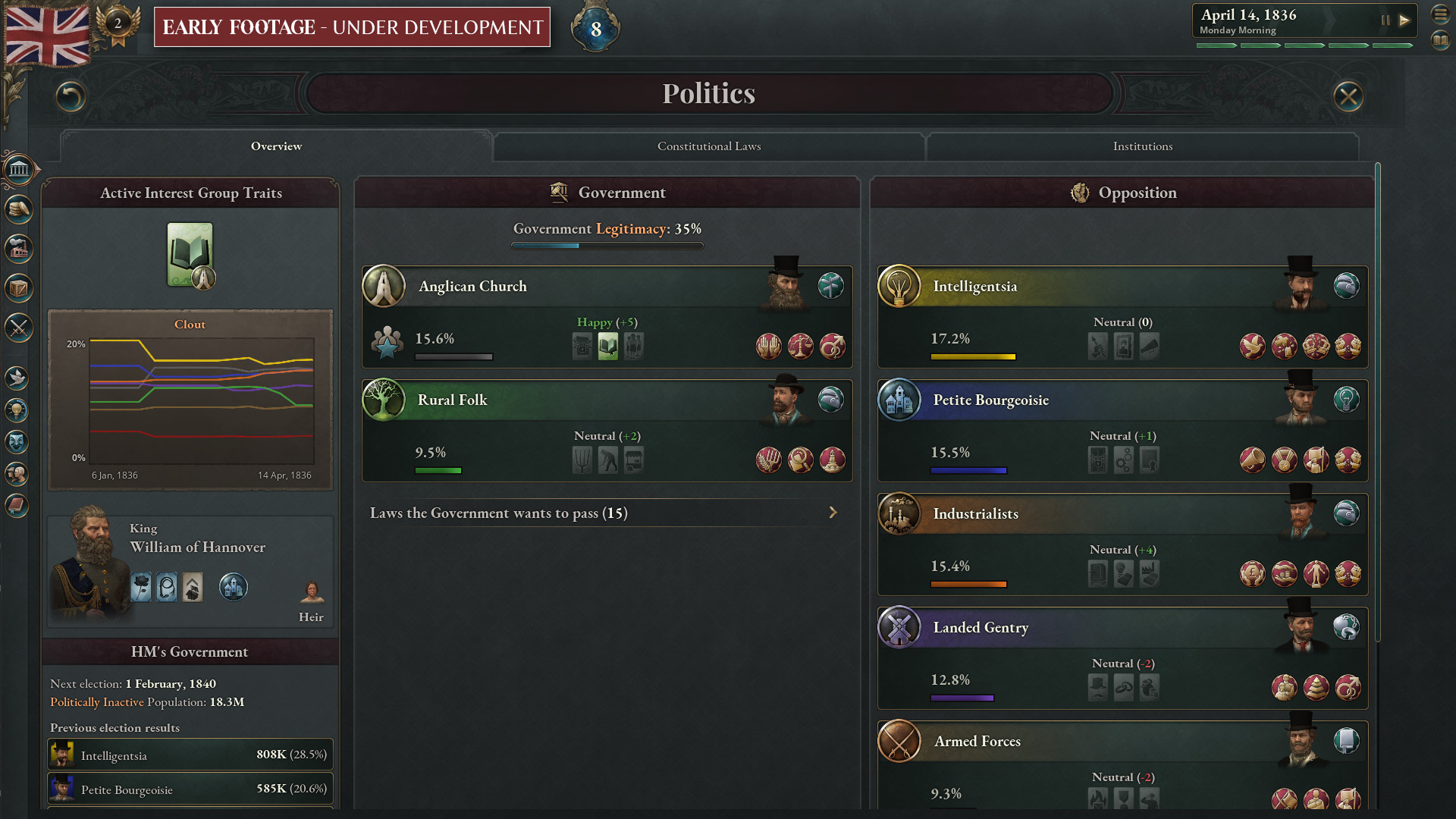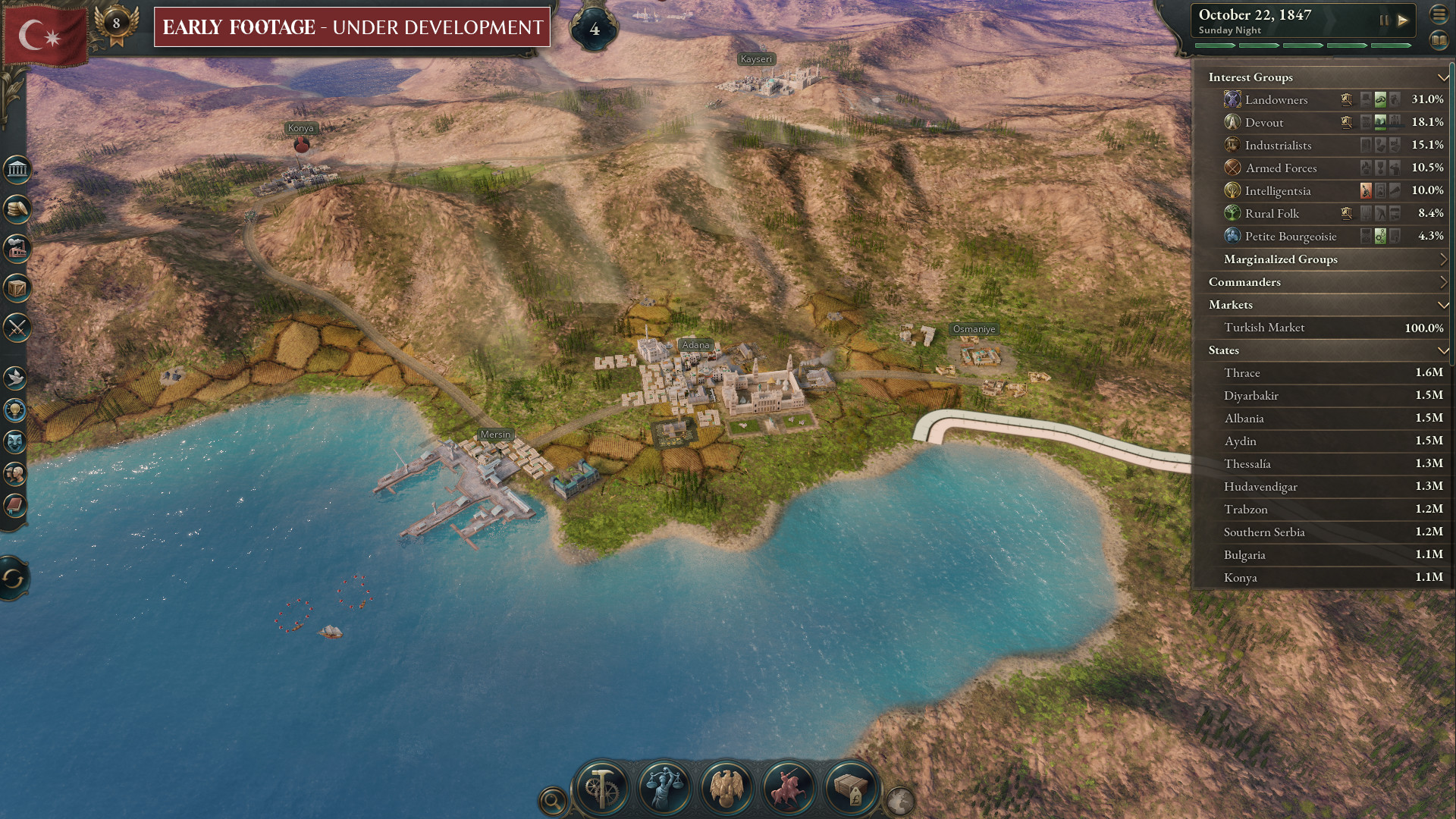SHAPE A GRAND TOMORROW
Paradox Development Studio invites you to build your ideal society in the tumult of the exciting and transformative 19th century. Balance the competing interests in your society and earn your place in the sun in Victoria 3, one of the most anticipated games in Paradox’s history.THE ULTIMATE SOCIETY SIMULATOR
- Lead dozens of world nations from 1836-1936. Agrarian or Industrial, Traditional or Radical, Peaceful or Expansionist... the choice is yours.
- Detailed population groups with their own economic needs and political desires.
- Reform your government and constitution to take advantage of new social innovations, or preserve the stability of your nation by holding fast to tradition in the face of revolutionaries.
- Research transformative new technology or ideas to improve your national situation.
DEEP ECONOMIC SYSTEM
- Expand your industry to take advantage of lucrative goods, taxing the profits to improve national prosperity.
- Import cheap raw materials to cover your basic needs while finding new markets for your finished goods.
- Secure vital goods to fuel your advanced economy and control the fate of empires.
- Balance employing available labor force with the needs for new types of workers.
PLAY ON A GRAND STAGE
- Use your diplomatic wiles to weave a tangled global web of pacts, relations, alliances, and rivalries to secure your diplomatic position on the world stage.
- Employ threats, military prowess and bluffs to persuade enemies to back down in conflicts.
- Increase your economic and military strength at the expense of rivals.
- Accumulate prestige and the respect of your rivals as you build an industrial giant at home or an empire abroad.
Dev Diary #114 - The Great Game
Throughout the nineteenth century, Russia and Britain competed with one another for influence in Asia. This period of rivalry was known colloquially as the Great Game, beginning in the Caucasus and Central Asia, and expanding over time to include struggles for influence in areas as far away as Korea and China.
The new Great Game objective diverges from the more sandbox-oriented objectives by serving as a guided tour of this period in history. Whilst much of the content involved in the Great Game is available to owners of Sphere of Influence during every playthrough, the Great Game objective contains objective subgoals designed to guide the player through this content and represent the progress of the Great Game as a whole.
To ensure the best experience, the Great Game objective is only available for the six historical participants specified belowRussia, Britain, Persia, Kabul, Herat, and Kandahar.

Upon launching the Great Game, the first thing one will see is a list of objective subgoals, along with the subgoal which represents the core of the Great Game. The Great Game objective mixes country-specific and generic objectiveswhilst both Britain and Russia have the objective of securing influence over Persia or creating an Afghan protectorate, they also have country-specific objectives which will be covered later in the diary.

The Great Game core subgoal is where the progress of each nation in the Great Game is tracked. Completing each subgoal will benefit the nation that completes it, pushing the bar to the right or the left. The bar will also drift in one direction or another each year, according to differences in national prestige and market GDP.
As can be seen here, there are three currently unopened questions in the Great Gamethe fate of the Caucasian states, and the struggle for influence over Afghanistan and Persia. These are victories to be had. Both Britain and Russia have made advances before the games start, with Britain benefiting from their successful expedition through the Hindu Kush and into Bukhara in 1831, and Russia benefiting from enforcing the Treaty of Turkmenchay in 1828. In the Great Game, Victories represent conflicts within which both powers vie against one another, and advances represent more technical, military, or diplomatic achievements.

When the journal entry concludes, the position of the bar will determine whether the Great Game has a victor, or whether neither power was able to gain supremacy. The power that wins the Great Game will receive a prestige and Power Bloc cohesion bonus, and the nation which is defeated will be humiliated in the eyes of the world.


Of course, the Great Game does not always have a winner. Contrary to the views of the imperial administrators vying over the territories of Central Asia, the people which reside there have agendas of their own. If, whilst playing as a Central Asian or Persian power, one pushes both Britain and Russia out of the region, the Great Game will be forced to a close with both Great Powers being humbled.
Whilst both Britain and Russia have their unique national priorities, the core of the Great Game lies in the battle for leverage over Central Asia. Both Great Powers have generic subgoals for acquiring influence in this region.
In Afghanistan, for example, one may establish a protectorate over all the nations in the regionbut the process does not stop there. The power which successfully establishes a protectorate over Afghanistan must keep it for ten years, without any Afghan states slipping out of their grasp.

At the games start, Afghanistans borders are quite different from what they were at the end of the period. This is owed to the Anglo-Russian Agreement of 1895, in which Russia and Britain jointly decided upon the borders of the Afghan state. Once Afghanistan unifies, a journal entry modelling this will appear for both Britain and Russia, along with an objective subgoal for those playing the Great Game.

The Pamir Delimitation journal entry represents the negotiations between Britain and Russia to determine the borders of Afghanistan. Depending on the borders of Afghanistan at the beginning of the process, the journal entry will present a variety of different proposals, permitting the Great Powers to grant or claim a varying amount of land.
Pictured: Britain has decided that Afghanistans southeastern border should be drawn along the Indus River, whilst Russia has decided upon giving it some territory in the North.
Once both Great Powers have agreed to a treaty, it is presented to Afghanistan, which has the option to accept or refuse. If Afghanistan refuses, the Great Powers will need to do another round of negotiation, this time with additional coercive measures available to them.



If Afghanistan continues to refuse or the Great Powers fail to come to a deal, negotiations will break down, and overlapping claims will almost guarantee future wars in the region.
Pictured: Some of the shapes that a post-Pamir Delimitation Afghanistan may take. Some of these may prove more viable than others.
The requirements for successfully completing the subgoal to secure influence over Persia is similar to Afghanistan, with the caveat that the territorial integrity of Persia must be maintained, at least to some extent. The fluid borders and expansionist ambitions of Persia, which will be shown in more detail next week, mean that Persia may take many shapes over the course of a game.

Throughout the late nineteenth centuries, European explorers constantly attempted to penetrate through the Himalayan Mountains, to chart the Tibetan Plateau and determine the best routes for a military expedition into the interior of China. Sphere of Influence adds a new expedition into the Himalayas, with ramifications for the Great Game if successfully completed.

Whilst your explorers survey the roof of the world, they may come across many things, from mountains higher than any seen before, or fascinating wildlife.

In addition to the risk of losing life or limb to both frostbite and the wildlifes claws, any European expeditions trespassing into this region will run the risk of causing diplomatic incidents with China. It is best to tread cautiously, lest the expedition be sent back humiliatedor not come back at all.

In the Great Game objective, the majority of objectives are country-specific. In many cases, these objectives are linked to journal entries that are available for a country in any playthrough, with the objectives serving as a way to point out specific journal entries and grant the player points in the Great Game for completing them.
For example, in Russia, the Secure the Persian Border objective is tied to a new journal entry that is available for Russia at the games start.

The Caucasian War is a conflict that has been raging for some time at the beginning of the game, beginning with the Russian attempt to annex Circassia in the mid-eighteenth century. In 1836, the Caucasian Imamate and Circassia continue to resist Russian domination of the region, making much of the region effectively ungovernable. Russian control of the South Caucasus is exerted primarily through the Georgian Military Highwaya route constantly threatened by the unrest in the North Caucasus. If Russia loses control of the North Caucasus, it is certain to lead to the loss of the South as well.

Whilst the Caucasian War journal entry is active, events will intermittently fire, covering various situations related to the war. The options in these events often increase devastation in the region, which will make things more difficult for the Imamate and Circassia, at the cost of spilling out into Russian-controlled regions as well.



Once Russia has either successfully researched certain technologies or reached the end of its starting truce, the war may be escalated into a full-scale conflict, which permits the use of ordinary diplomatic plays against these nations.

Upon escalating the war, the Russian armed forces in the Caucasus will present the historical Milyutin memorandum to the government. Accepting this memorandum will please the command of the armed forces, but lead to the historical outcome of the Caucasian Warthe devastation of the region, depopulation, and the forceful expulsion of much of the Circassian population to the Ottoman Empire.

Circassia and the Caucasian Imamate also have content related to the conflict, which will be shown off in the next dev diary.
The rest of the Caucasian War requires the Sphere of Influence DLC, but the content pertaining to the Milyutin memorandum and brutal depopulation of the Caucasus does not. Whilst this is a gruesome event in history, it is also not something which can in good conscience be overlooked.
As of 1836, the Kazakh steppes have been under the Russian Empire for several decades. The power of the Khan has recently been abolished, and the Kazakh zhuzes placed under the command of various Russian-appointed agha-sultans. However, this system of administration is beginning to fray. Early in the game, Russia will receive an event notifying them of the rise of Kenesary Kasymuli, a Kazakh aristocrat who has come to spearhead Kazakh resistance against Russian rule.

When this event occurs, a new unresolved victory appears in the Great Game central subgoal, and a new subgoal, along with its corresponding Journal Entry, appears.


The Pacification of the Steppes journal entry is completed by slowly and peacefully annexing the Kazakh protectorates, and fails if the Kazakh protectorates liberty desire rises too high, or if ten years pass without successfully achieving this goal.

Whilst the journal entry is active, events pertaining to Kenesarys rebels will fire, possibly interfering with the liberty desire of Russias Kazakh subjects.

In addition to firing events for Russia, Kenesary will also fire events for the Kazakh zhuzes and the Central Asian khanates, giving them a chance to side with Kenesary when he eventually launches his final play for control of Kazakhstan.

If Russian rule is sufficiently disrupted, and Liberty Desire reaches too high a value, Kenesary will seize control of the Uly Zhuz and launch his independence war against Russia, along with the allies that hes collected along the way.


If Russia can successfully crush the revolt, they will gain progress in the Great Gamebut it has far more to lose than to gain. Whilst Britain is not necessarily aiding Kenesary, his victory will represent a coup for Britain, as Russia now has much more work to do to reach Afghanistan.

If Russia succeeds, it will have an opportunity to menace the other Central Asian Khanates, and, upon researching Civilising Mission, unlock a new journal entrythe Conquest of Turkestan.


Throughout the course of a game, Russia will periodically unlock additional subgoals which will advance its position in the Great Game. These subgoals represent various historical aims of Russia, and are exclusive to the Great Game objective.
The Codify the Chinese Border subgoal represents the Russian Empires desire for the various territorial concessions in Central Asia and Outer Manchuria signed away by the Qing Empire in the mid-nineteenth century. The acquisition of Outer Manchuria was instrumental to the ability for the Russian Empire to project power into the Pacific Ocean, a situation which eventually led to British concerns over the integrity of their Pacific colonies and their later alliance with Japan.
To complete this subgoal, Russia must both acquire these territories from China, and force China to abandon claims on the territory. If a non-player China has been weakened by the Opium Wars and other calamities, the options to sign the Treaty of Aigun, Beijing Treaty, and Chuguchak Protocol provided by the Ruler of the East Journal Entry are a perfect way to see this goal through whilst minimising both the risk of war and the negative implications of a revanchist China on the border.

The Acquire Manchurian Concessions subgoal also relates to the relations between China and Russia, and is triggered by the Russian acquisition and incorporation of a state in Outer Manchuria. This subgoal encourages Russia to acquire a treaty port in Manchuria, and construct the historical Chinese Eastern Railway, which served as the furthest Eastern branch of the trans-Siberian railway until the opening of the Amur River Line in 1916.

With the Russian acquisition of Outer Manchuria also comes ambitions to secure a protectorate over Korea. Korea was considered to present a risk in the hands of a foreign power as a staging point for the decapitation of Russias Far Eastern naval assets. Historically, the Russian Empire contended diplomatically with Japan for influence in Korea following the first Sino-Japanese war, a period which would meet its climax with a Japanese-sponsored coup killing the Queen of Korea and forcing the King to flee to the Russian embassy.
This period of heightened tensions between the modernising Empire of Japan and Russia would cool for a brief period with the establishment of several agreements that would establish a balance of power in Korea. These agreements would come to an end following the end of the Russo-Japanese war, and the later Japanese conquest of Korea. The Secure a Korean Protectorate subgoal represents an alternate routethe ambition of both Nicholas II and factions within his government to establish full Russian control of Korea.

In the 1830s, British citizens and ships played a role in assisting Circassia against Russia. Whilst Britain was historically unwilling to escalate its involvement in Circassia beyond occasional shipments of weapons or volunteers dispatched by private citizens, it considered exerting influence into the Black Sea to be in its national interest.
The Disrupt the Russian Caucasus subgoal represents the various initiatives amongst British civil and political society to assist Circassia, and react to what they saw as the threat of Russia taking control of the Ottoman Empire if it could consolidate its territories in the Caucasus.

The Expand British India subgoal represents the desire to expand the territories controlled by the East India Company into Burma and modern-day Pakistan. A strong East India Company, or British Raj, may serve as a valuable counterweight to Russian influence in the region, and a centre from which Britain may project power into the remainder of Asia.

The Contest the Russian Pamirs subgoal represents an abortive attempt in 1902 by Britain to seize control of the Pamir Mountains and establish an independent buffer state through a deeply unsubtle methoda direct military incursion with cooperation from Afghanistan.
Whilst this proposition was historically rejected by the British government before materialising, the acquisition of Tajikistan by Russia will present Britain the opportunity to launch the proposed invasion. If Britain can manage to seize Tajikistan or establish a new Tajik state in its power bloc, it will gain a decisive advantage in the Great Game.

The final unique subgoal for Britain is to counter Russian Pacific Influence. This represents the historical Anglo-Japanese Alliance of 1902, which was formed in reaction to the strengthening of the Russian presence in its Far Eastern territories. This subgoal is triggered by Russia developing naval bases in Outer Manchuria, heralding an incoming threat to the British fleet in the Pacific.

Next week, I will cover the content for minor nations involved with the Great Game, as well as how sandbox mode works with the new content. And that is all. Thank you for reading.

Hello. This is Victoria, and today I will be covering much of the Great Game-themed narrative content which is coming in Sphere of Influence. This will be the first dev diary covering narrative content, with the second covering minor nations in the Great Game and other related content.
The Great Game
Throughout the nineteenth century, Russia and Britain competed with one another for influence in Asia. This period of rivalry was known colloquially as the Great Game, beginning in the Caucasus and Central Asia, and expanding over time to include struggles for influence in areas as far away as Korea and China.
The new Great Game objective diverges from the more sandbox-oriented objectives by serving as a guided tour of this period in history. Whilst much of the content involved in the Great Game is available to owners of Sphere of Influence during every playthrough, the Great Game objective contains objective subgoals designed to guide the player through this content and represent the progress of the Great Game as a whole.
To ensure the best experience, the Great Game objective is only available for the six historical participants specified belowRussia, Britain, Persia, Kabul, Herat, and Kandahar.

Upon launching the Great Game, the first thing one will see is a list of objective subgoals, along with the subgoal which represents the core of the Great Game. The Great Game objective mixes country-specific and generic objectiveswhilst both Britain and Russia have the objective of securing influence over Persia or creating an Afghan protectorate, they also have country-specific objectives which will be covered later in the diary.

The Great Game core subgoal is where the progress of each nation in the Great Game is tracked. Completing each subgoal will benefit the nation that completes it, pushing the bar to the right or the left. The bar will also drift in one direction or another each year, according to differences in national prestige and market GDP.
As can be seen here, there are three currently unopened questions in the Great Gamethe fate of the Caucasian states, and the struggle for influence over Afghanistan and Persia. These are victories to be had. Both Britain and Russia have made advances before the games start, with Britain benefiting from their successful expedition through the Hindu Kush and into Bukhara in 1831, and Russia benefiting from enforcing the Treaty of Turkmenchay in 1828. In the Great Game, Victories represent conflicts within which both powers vie against one another, and advances represent more technical, military, or diplomatic achievements.

When the journal entry concludes, the position of the bar will determine whether the Great Game has a victor, or whether neither power was able to gain supremacy. The power that wins the Great Game will receive a prestige and Power Bloc cohesion bonus, and the nation which is defeated will be humiliated in the eyes of the world.


Of course, the Great Game does not always have a winner. Contrary to the views of the imperial administrators vying over the territories of Central Asia, the people which reside there have agendas of their own. If, whilst playing as a Central Asian or Persian power, one pushes both Britain and Russia out of the region, the Great Game will be forced to a close with both Great Powers being humbled.
Generic Content
Whilst both Britain and Russia have their unique national priorities, the core of the Great Game lies in the battle for leverage over Central Asia. Both Great Powers have generic subgoals for acquiring influence in this region.
Afghanistan
In Afghanistan, for example, one may establish a protectorate over all the nations in the regionbut the process does not stop there. The power which successfully establishes a protectorate over Afghanistan must keep it for ten years, without any Afghan states slipping out of their grasp.

At the games start, Afghanistans borders are quite different from what they were at the end of the period. This is owed to the Anglo-Russian Agreement of 1895, in which Russia and Britain jointly decided upon the borders of the Afghan state. Once Afghanistan unifies, a journal entry modelling this will appear for both Britain and Russia, along with an objective subgoal for those playing the Great Game.

The Pamir Delimitation journal entry represents the negotiations between Britain and Russia to determine the borders of Afghanistan. Depending on the borders of Afghanistan at the beginning of the process, the journal entry will present a variety of different proposals, permitting the Great Powers to grant or claim a varying amount of land.
Pictured: Britain has decided that Afghanistans southeastern border should be drawn along the Indus River, whilst Russia has decided upon giving it some territory in the North.

Once both Great Powers have agreed to a treaty, it is presented to Afghanistan, which has the option to accept or refuse. If Afghanistan refuses, the Great Powers will need to do another round of negotiation, this time with additional coercive measures available to them.



If Afghanistan continues to refuse or the Great Powers fail to come to a deal, negotiations will break down, and overlapping claims will almost guarantee future wars in the region.
Pictured: Some of the shapes that a post-Pamir Delimitation Afghanistan may take. Some of these may prove more viable than others.

Persia
The requirements for successfully completing the subgoal to secure influence over Persia is similar to Afghanistan, with the caveat that the territorial integrity of Persia must be maintained, at least to some extent. The fluid borders and expansionist ambitions of Persia, which will be shown in more detail next week, mean that Persia may take many shapes over the course of a game.

Himalayan Exploration
Throughout the late nineteenth centuries, European explorers constantly attempted to penetrate through the Himalayan Mountains, to chart the Tibetan Plateau and determine the best routes for a military expedition into the interior of China. Sphere of Influence adds a new expedition into the Himalayas, with ramifications for the Great Game if successfully completed.

Whilst your explorers survey the roof of the world, they may come across many things, from mountains higher than any seen before, or fascinating wildlife.

In addition to the risk of losing life or limb to both frostbite and the wildlifes claws, any European expeditions trespassing into this region will run the risk of causing diplomatic incidents with China. It is best to tread cautiously, lest the expedition be sent back humiliatedor not come back at all.

Country-Specific Content
In the Great Game objective, the majority of objectives are country-specific. In many cases, these objectives are linked to journal entries that are available for a country in any playthrough, with the objectives serving as a way to point out specific journal entries and grant the player points in the Great Game for completing them.
The Caucasian War
For example, in Russia, the Secure the Persian Border objective is tied to a new journal entry that is available for Russia at the games start.

The Caucasian War is a conflict that has been raging for some time at the beginning of the game, beginning with the Russian attempt to annex Circassia in the mid-eighteenth century. In 1836, the Caucasian Imamate and Circassia continue to resist Russian domination of the region, making much of the region effectively ungovernable. Russian control of the South Caucasus is exerted primarily through the Georgian Military Highwaya route constantly threatened by the unrest in the North Caucasus. If Russia loses control of the North Caucasus, it is certain to lead to the loss of the South as well.

Whilst the Caucasian War journal entry is active, events will intermittently fire, covering various situations related to the war. The options in these events often increase devastation in the region, which will make things more difficult for the Imamate and Circassia, at the cost of spilling out into Russian-controlled regions as well.



Once Russia has either successfully researched certain technologies or reached the end of its starting truce, the war may be escalated into a full-scale conflict, which permits the use of ordinary diplomatic plays against these nations.

Upon escalating the war, the Russian armed forces in the Caucasus will present the historical Milyutin memorandum to the government. Accepting this memorandum will please the command of the armed forces, but lead to the historical outcome of the Caucasian Warthe devastation of the region, depopulation, and the forceful expulsion of much of the Circassian population to the Ottoman Empire.

Circassia and the Caucasian Imamate also have content related to the conflict, which will be shown off in the next dev diary.
The rest of the Caucasian War requires the Sphere of Influence DLC, but the content pertaining to the Milyutin memorandum and brutal depopulation of the Caucasus does not. Whilst this is a gruesome event in history, it is also not something which can in good conscience be overlooked.
Kazakhstan
As of 1836, the Kazakh steppes have been under the Russian Empire for several decades. The power of the Khan has recently been abolished, and the Kazakh zhuzes placed under the command of various Russian-appointed agha-sultans. However, this system of administration is beginning to fray. Early in the game, Russia will receive an event notifying them of the rise of Kenesary Kasymuli, a Kazakh aristocrat who has come to spearhead Kazakh resistance against Russian rule.

When this event occurs, a new unresolved victory appears in the Great Game central subgoal, and a new subgoal, along with its corresponding Journal Entry, appears.


The Pacification of the Steppes journal entry is completed by slowly and peacefully annexing the Kazakh protectorates, and fails if the Kazakh protectorates liberty desire rises too high, or if ten years pass without successfully achieving this goal.

Whilst the journal entry is active, events pertaining to Kenesarys rebels will fire, possibly interfering with the liberty desire of Russias Kazakh subjects.

In addition to firing events for Russia, Kenesary will also fire events for the Kazakh zhuzes and the Central Asian khanates, giving them a chance to side with Kenesary when he eventually launches his final play for control of Kazakhstan.

If Russian rule is sufficiently disrupted, and Liberty Desire reaches too high a value, Kenesary will seize control of the Uly Zhuz and launch his independence war against Russia, along with the allies that hes collected along the way.


If Russia can successfully crush the revolt, they will gain progress in the Great Gamebut it has far more to lose than to gain. Whilst Britain is not necessarily aiding Kenesary, his victory will represent a coup for Britain, as Russia now has much more work to do to reach Afghanistan.

If Russia succeeds, it will have an opportunity to menace the other Central Asian Khanates, and, upon researching Civilising Mission, unlock a new journal entrythe Conquest of Turkestan.


Other Russian Subgoals
Throughout the course of a game, Russia will periodically unlock additional subgoals which will advance its position in the Great Game. These subgoals represent various historical aims of Russia, and are exclusive to the Great Game objective.
The Codify the Chinese Border subgoal represents the Russian Empires desire for the various territorial concessions in Central Asia and Outer Manchuria signed away by the Qing Empire in the mid-nineteenth century. The acquisition of Outer Manchuria was instrumental to the ability for the Russian Empire to project power into the Pacific Ocean, a situation which eventually led to British concerns over the integrity of their Pacific colonies and their later alliance with Japan.
To complete this subgoal, Russia must both acquire these territories from China, and force China to abandon claims on the territory. If a non-player China has been weakened by the Opium Wars and other calamities, the options to sign the Treaty of Aigun, Beijing Treaty, and Chuguchak Protocol provided by the Ruler of the East Journal Entry are a perfect way to see this goal through whilst minimising both the risk of war and the negative implications of a revanchist China on the border.

The Acquire Manchurian Concessions subgoal also relates to the relations between China and Russia, and is triggered by the Russian acquisition and incorporation of a state in Outer Manchuria. This subgoal encourages Russia to acquire a treaty port in Manchuria, and construct the historical Chinese Eastern Railway, which served as the furthest Eastern branch of the trans-Siberian railway until the opening of the Amur River Line in 1916.

With the Russian acquisition of Outer Manchuria also comes ambitions to secure a protectorate over Korea. Korea was considered to present a risk in the hands of a foreign power as a staging point for the decapitation of Russias Far Eastern naval assets. Historically, the Russian Empire contended diplomatically with Japan for influence in Korea following the first Sino-Japanese war, a period which would meet its climax with a Japanese-sponsored coup killing the Queen of Korea and forcing the King to flee to the Russian embassy.
This period of heightened tensions between the modernising Empire of Japan and Russia would cool for a brief period with the establishment of several agreements that would establish a balance of power in Korea. These agreements would come to an end following the end of the Russo-Japanese war, and the later Japanese conquest of Korea. The Secure a Korean Protectorate subgoal represents an alternate routethe ambition of both Nicholas II and factions within his government to establish full Russian control of Korea.

British Subgoals
In the 1830s, British citizens and ships played a role in assisting Circassia against Russia. Whilst Britain was historically unwilling to escalate its involvement in Circassia beyond occasional shipments of weapons or volunteers dispatched by private citizens, it considered exerting influence into the Black Sea to be in its national interest.
The Disrupt the Russian Caucasus subgoal represents the various initiatives amongst British civil and political society to assist Circassia, and react to what they saw as the threat of Russia taking control of the Ottoman Empire if it could consolidate its territories in the Caucasus.

The Expand British India subgoal represents the desire to expand the territories controlled by the East India Company into Burma and modern-day Pakistan. A strong East India Company, or British Raj, may serve as a valuable counterweight to Russian influence in the region, and a centre from which Britain may project power into the remainder of Asia.

The Contest the Russian Pamirs subgoal represents an abortive attempt in 1902 by Britain to seize control of the Pamir Mountains and establish an independent buffer state through a deeply unsubtle methoda direct military incursion with cooperation from Afghanistan.
Whilst this proposition was historically rejected by the British government before materialising, the acquisition of Tajikistan by Russia will present Britain the opportunity to launch the proposed invasion. If Britain can manage to seize Tajikistan or establish a new Tajik state in its power bloc, it will gain a decisive advantage in the Great Game.

The final unique subgoal for Britain is to counter Russian Pacific Influence. This represents the historical Anglo-Japanese Alliance of 1902, which was formed in reaction to the strengthening of the Russian presence in its Far Eastern territories. This subgoal is triggered by Russia developing naval bases in Outer Manchuria, heralding an incoming threat to the British fleet in the Pacific.

Next week, I will cover the content for minor nations involved with the Great Game, as well as how sandbox mode works with the new content. And that is all. Thank you for reading.
[ 2024-04-25 14:00:27 CET ] [Original Post]
Minimum Setup
- OS: TBC
- Processor: TBC
- Graphics: TBCSound Card: TBC
Recommended Setup
- OS: TBC
- Processor: TBC
- Graphics: TBCSound Card: TBC
GAMEBILLET
[ 6374 ]
FANATICAL
[ 5785 ]
GAMERSGATE
[ 751 ]
MacGameStore
[ 2194 ]
FANATICAL BUNDLES
GMG BUNDLES
HUMBLE BUNDLES
by buying games/dlcs from affiliate links you are supporting tuxDB

